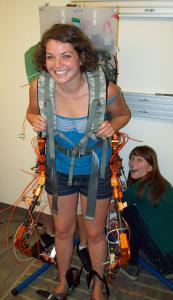Rachel Rieger: Managing and Recycling Human Energy: A Redesign of the Lower Limb Exoskeleton
| Attachment | Size |
|---|---|
| 887 KB | |
| 1.43 MB |
Lower limb exoskeletons are a staple in military research because they allow soldiers to carry heavy loads without enduring the weight. The existing lower limb exoskeletons are either gas or battery powered and therefore are not practical for extended periods of time. My research aim was the mechanical redesign of the pneumatic system of the LEX (UCSC’s Lower Limb Exoskeleton) in order to harvest energy absorbed from the knee and ankle joints during the human walking (gait) cycle, and expel it back through the hip and ankle joints as renewable energy.
The gait cycle consists of controlled falls which are essentially forward momentum. Using this momentum and gravity, energy can be harvested when the joints exhibit flexion. This energy transfer is accomplished by compressing air cylinders at the knee and ankle joints at specific points in the gait cycle and storing it in a reservoir tank. The compressed air is then released at distinct time intervals to the hip and ankle joints to expand the respective air cylinders to create forward motion. The timing of valve openings was determined by weighing the smoothness of the LEX movement versus the amount of work it could produce. An instantaneous pressure release would cause a jerky movement with maximum work whereas a longer time release allows for minimal work and smoother walking.
By recycling energy from the knee and ankle, the LEX will be able to support a portion of the wearers load without any pneumatic power supply or time restraints. The energy harvested from the knee will be released into the hip, while the energy acquired from the ankle will be expelled back into the ankle. Using this balance, nearly 10% of the total energy needed to walk while supporting a heavy load will come from recycled energy. This will allow soldiers in the field, and eventually all backpackers, to support heavier loads with less muscle restriction and fatigue.
